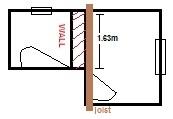Hi,
We are looking to knock down a brick wall between our bathroom and toilet to make one room.
There is no wall beneath the wall to be removed and loft space above it. There is a joist that runs the length of the wall but offset (only approx 1cm of joist actual sits on the wall). This is the only wall that the joist runs parallel with.
Attached is a diagram I have done to show this.
Can anyone advise if this is a supporting wall and can it simply be removed without support? Or can anyone advise how I can tell?
many thanks
We are looking to knock down a brick wall between our bathroom and toilet to make one room.
There is no wall beneath the wall to be removed and loft space above it. There is a joist that runs the length of the wall but offset (only approx 1cm of joist actual sits on the wall). This is the only wall that the joist runs parallel with.
Attached is a diagram I have done to show this.
Can anyone advise if this is a supporting wall and can it simply be removed without support? Or can anyone advise how I can tell?
many thanks


